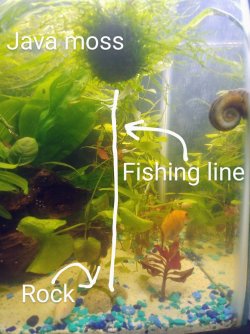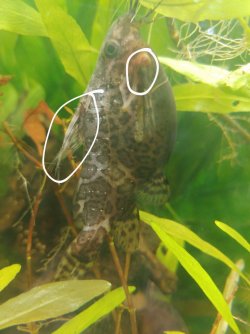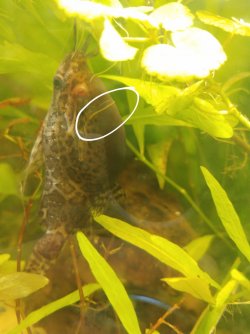I turned my 29 gallon tank light on this morning to find one of my Upside down cats completely tangled in fishing line. I have floating java moss balls from petco and the fishing line attaches to a rock so it's in the middle of the tank. I can't get a pic of the catfish since he's hiding now. I cut the fishing line off the java moss and very gently scooped him and the rock he was stuck to into a separated bucket of tank water. I took tiny scissors and gently cut the fishing line off him. It was wrapped around him in 5 places  I put him back in my 29 gallon so he could hide in his driftwood and go back with the group of upside down cats. He's really pale, his dorsal fin is completely shredded down to his back and half of it is missing, his dorsal fin is bleeding, under his neck the fishing line was wrapped really tight and he has a small cut and an indented line where it was wrapped, he has some scales sticking up from where the fishing line was wrapped, and he's breathing heavy.
I put him back in my 29 gallon so he could hide in his driftwood and go back with the group of upside down cats. He's really pale, his dorsal fin is completely shredded down to his back and half of it is missing, his dorsal fin is bleeding, under his neck the fishing line was wrapped really tight and he has a small cut and an indented line where it was wrapped, he has some scales sticking up from where the fishing line was wrapped, and he's breathing heavy.  How should I treat my tank so he can heal and not get infections? Please help I feel awful that this happened. How else should I secure the Java Moss so this doesn't happen again?
How should I treat my tank so he can heal and not get infections? Please help I feel awful that this happened. How else should I secure the Java Moss so this doesn't happen again?
@Colin_T @NCaquatics
Edit: I now see he has 2 lines on his throat where the fishing line was and he has a swollen bump on one of his front fins as well
 I put him back in my 29 gallon so he could hide in his driftwood and go back with the group of upside down cats. He's really pale, his dorsal fin is completely shredded down to his back and half of it is missing, his dorsal fin is bleeding, under his neck the fishing line was wrapped really tight and he has a small cut and an indented line where it was wrapped, he has some scales sticking up from where the fishing line was wrapped, and he's breathing heavy.
I put him back in my 29 gallon so he could hide in his driftwood and go back with the group of upside down cats. He's really pale, his dorsal fin is completely shredded down to his back and half of it is missing, his dorsal fin is bleeding, under his neck the fishing line was wrapped really tight and he has a small cut and an indented line where it was wrapped, he has some scales sticking up from where the fishing line was wrapped, and he's breathing heavy.  How should I treat my tank so he can heal and not get infections? Please help I feel awful that this happened. How else should I secure the Java Moss so this doesn't happen again?
How should I treat my tank so he can heal and not get infections? Please help I feel awful that this happened. How else should I secure the Java Moss so this doesn't happen again?@Colin_T @NCaquatics
Edit: I now see he has 2 lines on his throat where the fishing line was and he has a swollen bump on one of his front fins as well
Last edited:





